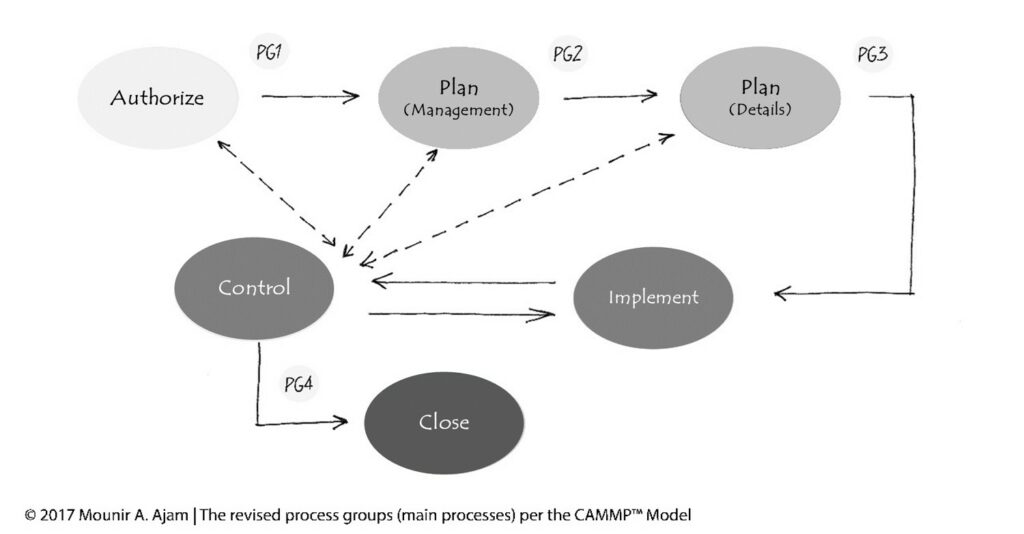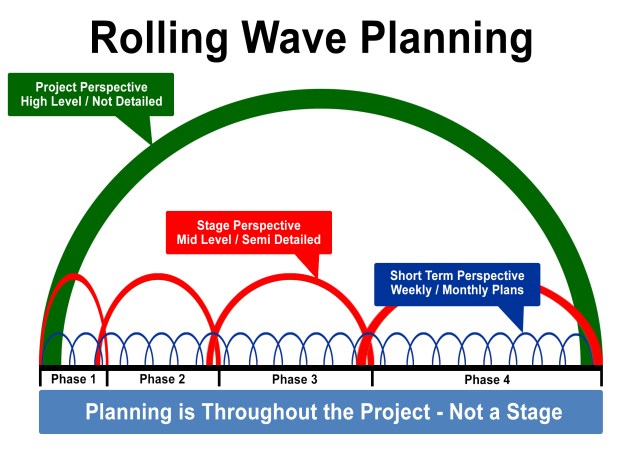In the past, we wrote a series of posts and recorded videos on project scheduling, including rolling wave planning. Further, in our main book on CAMMP, Project Management beyond Waterfall and Agile, we also addressed planning in general. In the book, we stressed the need to think, act, and manage at the project level and at the stage level. Today, we have received a request, from a professional who is taking one of the SUKAD PM Quest online courses. The learner’s question triggered this post.
The Request from the PM Quest Learner
“I am pretty much happy to have completed this course, I believe you would be kind enough to show me how to apply rolling wave planning in MS Project from the course’s perspective?
What I mean is to Initiate, Plan, Monitor&Control, and Close the phase applying rolling wave planning in MS Project? Suffice to say a TEMPLATE shall be adequate in this regard.
Warm regards,”
Name withheld for confidentiality
The Quick Answer
There are no templates for something like this. Templates are specific to a project type and would be different if we are talking about project planning (and project scheduling) or stage planning. For example, a template for Software projects would be different from the Facilities projects. The template for the whole project would also be different from a template to a given stage.
What SUKAD is working on is to include such templates in the Uruk PPM Platform for the different types of projects.
Planning versus Scheduling
It is critical to differentiate between planning and scheduling.
A plan, in the project management context, includes scope, cost, quality, risk, and other subjects. The way we view a schedule is as “a time-dependent representation of the plan.” The scope of work, along with all of the other aspects, are directly and indirectly represented on a timeline using project scheduling.
To keep this discussion sane, we will focus on the project scheduling part.
Rolling Wave Planning – Project Scheduling
In order not to repeat too much information, we suggest you watch a video, click here for the video. In summary, planning starts from the time management accepts the project brief. The project brief is the output of the concept stage in CAMMP. However, the initial plan would be the least detailed and highly conceptual. As the team progresses from one stage to another, they would be able to add details, hence the need for rolling wave planning. In other words, we plan at the project level, then we add details at the stage level.
Before leaving this part, remember, Planning is Not a Phase since planning happens from the concept stage, as we just mentioned, all the way to PROJECT closure.
Project Level Examples
The following is an image that shows the highest level of a schedule for a project, building a Ziggurat. Please note that the durations shown are only for presentation purposes. They do vary significantly from one domain to another.

The next image, include the stages of such a project, from the CAMMP Standard Model. The standard model means no customizations or tailoring. Please note that in these images, we are assuming Finish-to-Start, in most situations. In real life, this would not be accurate since there will be overlaps.

In an organization with useful historical data, the PMT can produce the above schedule as early as the Concept Stage.
The Uruk PPM Platform will include all projects that the organization has, if completed using Uruk or uploaded to Uruk PPM. The platform will also include all active projects. This feature would expedite all of the project steps that we are discussing here.
Rolling Wave Planning – Stage Level
Short Duration Projects
To present an example, we need to select a stage. However, keep in mind that the concept applies to any industry or type of works. Also, the project and stage have to be substantial in terms of duration. If the whole project, or stage, is only a few weeks in length, rolling wave planning might not be needed. However, even on short-duration work, the team can use it simplistically.
The Stage of a Project (example)
Let us take engineering or a construction phase as an example (major project). I chose this type since the person asking and triggered this discussion is in this domain. In the image above, we had used ‘Implementation Stage.’ However, for this type of project, implementation would be split into Engineering Stage and Construction Stage. This split is what we show in the next image.

Notice in the above image, we assumed that the first five stages are complete per the original plan. Great Job. By the time the team reaches the delivery phase, there will be more details. However, but we are ignoring that for now, to present the process.
Clarification
All of these steps are for the work within a stage; see image (from Project Management beyond Waterfall and Agile.

The Steps – Authorization
When you initiate a stage of a project, you probably have an idea about the stage work from history and how long it should take. The high-level project plan would have also included an initial schedule that might have details or no details. This is what we presented earlier.
Further, you might even have a contractual requirement.
So, at the start, your schedule might be one activity, Engineering Stage, or Construction Stage. In the real-world, for engineering or construction, we would have more details from the Project Management Plan. The team will revisit to confirm, update, and add detail.
The Steps – Management Planning
Once you start working on the stage (when it is handed to the team), you could probably add some milestones. For example, Site Prep, Subsurface Installations, etc. You do not have details, so perhaps only 10 major activities (+/-) with rough durations. This info can be in the Stage Authorization Document that the sponsor publishes to your PM and PMT (Project Management Team).
The work would be done as the PMT develops the Stage Management Plan.
The next image is a rough example of what this might look like. Please note, we are taking a simplistic approach.

The Steps – Detailed Planning
The next step in CAMMP™ is the Stage Detailed Plan, SDP. The SDP should contain the details of the work, including cost and schedule info. However, the first step is a detailed WBS that includes all of the work packages. Based on this, you can develop (or update) a Level III, Resource Loaded Schedule. That is the project schedule for implementation. It could have hundreds of work packages.
Since I am not a construction planner, and to limit this post short, I am not expanding the schedule for these work packages.
The Steps – Implementation
Typically, people would think we are done with planning. From this point on, we only need to monitor and control, but that is not the case.
The standard process in construction (or engineering) is that the PMT will do a Level IV Schedule, even Level V. The higher the number of the level = more details. Some of this detail would be by the project planner, or a construction planner working with the construction leads (superintendents). So, before the team starts site Prep Work, the planner/scheduler would do a detailed schedule for all of the work packages. The would likely plan for each week.
At another lower level, the construction foremen might even go down to daily schedules. Therefore, with every step, we add details. All of that would be in scheduling software like MS Project or Primavera.
Rolling Wave Planning – A Summary
The following image is a partial illustration of what we have presented here. This image shows:
- The high-level planning at the project level; the green arch. This would be a start to finish perspective with limited details. It would also depend on historical records.
- The red arches represent the stage level plans. Naturally, these plans would be more detailed than the project level but not as comprehensive as the next level.
- The blue arches represent monthly plans, weekly plans, or a significant deliverable plan. The type of plan and duration would be a function of project type and organizational preferences.
What is not shown here is any lower-levels, such as the work that could be done for weekly or daily planning and scheduling.

Closing Comments
We hope that this explanation answers the question by the PM Quest Learner. Unfortunately, I am traveling and staying with my in-laws, so I have limited abilities to record another video on the subject. Maybe in the future.
If you anyone have any other questions about this post or others, please let us know and would be happy to answer.

What’s up, yes tuis piece of writing is actually pleasant and I have learned lot of things
from it regarding blogging. thanks.
my web site :: best dedicated servers